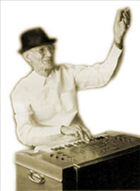


Ravages of time have not managed to diminish his charisma. Almost 80, this tall. handsome Punjabi exudes enough grace and grandeur to fill you with awe and admiration. You sense that burning pride deep down inside him - the pride of being a revolutionary trendsetting composer in Hindi film music; the pride of having lived his life on his own terms; the pride of being O.P. Nayyar!
The Beginning:

Onkar Prasad Nayyar alias OP was born on January 16, 1926 in Lahore. His father was a government servant. His family was not musically inclined but somehow this boy was obsessed by it right from childhood. After partition, he moved to Patiala and started working as a music teacher. The funny thing was that this 'teacher' had not had any formal musical training! Occasionally he even used to sing on All India Radio and some of his songs were quite popular in those days.
It was as a composer that he was destined to succeed. Preetam Aan Milo - one of his private compositions sung by C.H. Atma in his soulful Saigal-esque style became a rage all over India in 1948-49. Dalsukh Pancholi - a famous film producer of that time - was so impressed by that composition that he started to look for the composer to offer him his next film. He had to search really hard as the recording company had not even bothered to mention the composer's name on the record! Resourceful as he was, Pancholi finally tracked down the elusive composer and offered him the film Aasman. The year was 1952.
This debut was disastrous. Aasman, Chham Chhama Chham and Baaz - his first three films flopped in a row and even their soundtracks got a lukewarm response.
Enter Guru Dutt:
Despondent and dejected, OP had almost decided to bid goodbye to film music when the genius film-maker Guru Dutt offered him a film Aar Paar (1954). That was to prove the turning point. Songs like Babuji dheere chalna (Geeta Dutt), Sun sun, sun sun zaalima (GeetaRafi) and Kabhie aar kabhie paar (Shamshad) swept the nation off its feet with their verve and vitality. The next two Guru Dutt- entertainers Mr. And Mrs. 55 and CID then firmly established OP as a trendsetter with swingers like Jaane kahan mera jigar gaya ji. O leke pahela pahela pyar and Aankhon hi aankhon mein ishara ho gaya.
Different Music:
What made OP's music different? He shifted the then conventional equilibrium of the film song by taking away the focus from 'melody' to 'rhythm.' He was the original 'rhythm king' of Hindi film music, if you discount Ghulam Haider’s brief stint in the forties. By fusing his Punjabi folk style with Western rock 'n' roll, he invented a blend of music, which was racy and rhythmic. Pace and pep, zing and zest were its strong points. Though repetitiveness of tunes and orchestration, and frivolity of lyrics often plagued his music, it never failed to woo the listeners. What it sometimes lacked in class, it made up in catchiness. In fact this OP-brand of music had become such a rage in the late 50s that even composers of Madanmohan's caliber resorted to it on many occasions.
Shaping up the singers:
Although initially Geeta Dutt and Shamshad Begum got the prime female solos in his music, it was Asha Bhosle who proved to be his dream voice. In fact, Asha's rise to the top was pretty much engineered by OP. He was the composer who gave her the confidence to carry entire soundtracks on her own vocal stre